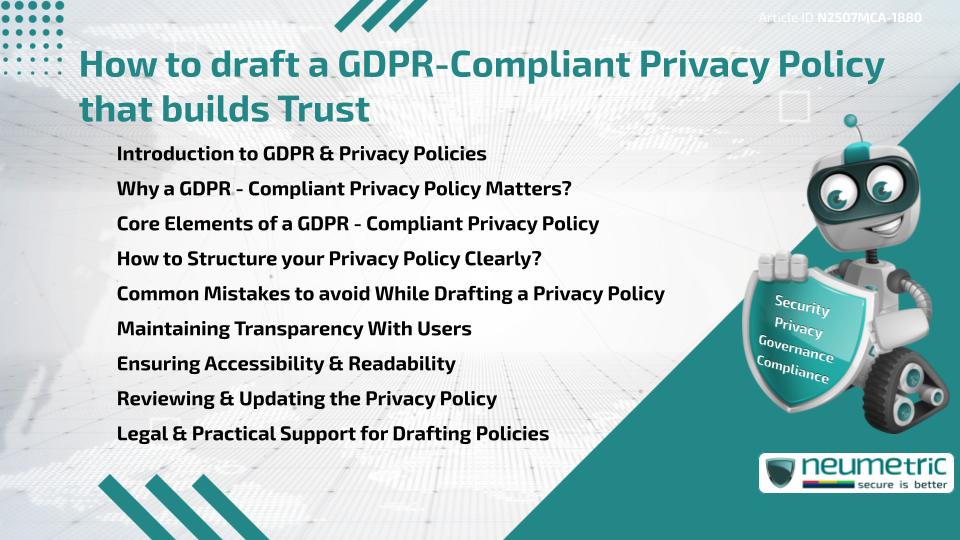Table of Contents
ToggleIntroduction to GDPR & Privacy Policies
The General Data Protection Regulation [GDPR] is a legal Framework created to protect the Personal Data & Privacy rights of individuals in the European Union. At the heart of GDPR Compliance lies the Privacy policy — a document that clearly outlines how an organisation collects, processes, stores & shares Personal Data.
Understanding How to draft a GDPR – compliant Privacy policy is crucial not only for legal reasons but also to establish credibility with users. When done right, it becomes a powerful tool for building trust & demonstrating transparency.
Why a GDPR – Compliant Privacy Policy Matters?
A Privacy policy is more than a legal formality. It is a communication bridge between your organisation & your users. GDPR requires businesses to be transparent about data practices & failure to comply can result in heavy fines or loss of consumer trust.
Knowing How to draft a GDPR – compliant Privacy policy helps companies avoid legal Risks & positions them as responsible data custodians. More importantly, users are more likely to engage with platforms that clearly explain their rights & your responsibilities.
Core Elements of a GDPR – Compliant Privacy Policy
Understanding How to draft a GDPR – compliant Privacy policy starts with knowing what it must include. The policy should contain:
- The types of Personal Data being collected
- Purpose & legal basis for data collection
- Details of data retention periods
- Information about Third Party sharing
- Explanation of User rights under GDPR
- Contact details for the Data Protection Officer [DPO]
- Information about international data transfers
Each of these elements plays a vital role in ensuring full GDPR Compliance.
How to Structure your Privacy Policy Clearly?
Even the most accurate policy is ineffective if it is hard to read. Structuring your Privacy policy in a user – friendly format is key to Compliance & trust – building. Consider the following Best Practices:
- Use clear, everyday language
- Break down information using subheadings & bullet points
- Avoid legal jargon
- Keep sentences & paragraphs short
- Include a table of contents for easier navigation
Common Mistakes to avoid While Drafting a Privacy Policy
When exploring How to draft a GDPR – compliant Privacy policy, it’s helpful to understand what not to do. Common missteps include:
- Using generic or copy – pasted templates
- Not tailoring the policy to specific data practices
- Leaving out contact information for data – related queries
- Using complex legal terminology
- Failing to mention Third Party services or trackers
Avoiding these pitfalls ensures your policy meets both legal & User expectations.
Maintaining Transparency With Users
Transparency is a central requirement of GDPR. Your Privacy policy must not hide or obscure important information. Inform users clearly:
- What data do you collect?
- Why do you need it?
- Who do you share it with?
- How long do you retain it?
Make sure you update users about any policy changes & give them the option to withdraw consent. Transparency shows respect for User rights & reinforces credibility.
The EDPB Guidelines offer practical advice on how to communicate Privacy information effectively.
Ensuring Accessibility & Readability
If users cannot find or understand your Privacy policy, it fails its purpose. Ensure the policy is:
- Easily accessible from every page on your website or app
- Written at an appropriate reading level
- Available in all applicable languages for your User base
- Compatible with mobile & assistive devices
The Web Content Accessibility Guidelines (WCAG) can help improve digital accessibility, especially for individuals with disabilities.
Reviewing & Updating the Privacy Policy
Drafting a policy is not a one – time task. To stay GDPR – compliant, you must regularly review & update your Privacy policy. Key moments to update include:
- Launching a new service
- Integrating Third Party tools
- Expanding into new markets
- Adopting new data collection methods
Record each update clearly & mention the last revised date. This demonstrates your commitment to accountability.
Legal & Practical Support for Drafting Policies
While internal teams can draft a Privacy policy, consulting legal professionals or Privacy experts ensures alignment with current laws. Free tools & generators are available but should be used with caution.
Helpful non – commercial resources include:
- CNIL’s GDPR Toolkit
- Norwegian Data Protection Authority (Datatilsynet)
- Irish Data Protection Commission
These guides offer valuable checklists & templates tailored for various sectors.
Takeaways
- Learn How to draft a GDPR – compliant Privacy policy to build User trust & meet legal obligations
- Include all necessary GDPR elements such as legal basis, data rights & retention details
- Keep the structure simple, language clear & tone transparent
- Avoid boilerplate templates & legalese
- Update Policies regularly & make them accessible for all users
FAQ
What is a GDPR – compliant Privacy policy?
A GDPR – compliant Privacy policy explains how an organisation collects, uses & protects Personal Data in accordance with the General Data Protection Regulation.
Why is it important to know How to draft a GDPR – compliant Privacy policy?
Because it helps organisations avoid legal penalties, increases User trust & ensures data transparency.
What are the main sections that should be in a GDPR – compliant Privacy policy?
The policy should include data types collected, legal basis, user rights, retention periods, Third Party sharing & contact details.
Can I use a free template to draft my Privacy policy?
You may use it as a starting point but it must be customised to reflect your actual data practices to be truly GDPR – compliant.
How often should a Privacy policy be updated?
A Privacy policy should be reviewed & updated whenever there are changes in services, data collection or legal requirements.
Does GDPR require consent for all types of data processing?
Not always. Consent is one legal basis but others include contractual necessity & legal obligations.
Should the Privacy policy be displayed on every page?
Not always. Consent is one legal basis but others include contractual necessity & legal obligations.
Do non – EU companies need to draft a GDPR – compliant Privacy policy?
Yes, if they process the Personal Data of EU residents, even if the company is located outside the EU.
Need help?
Neumetric provides organisations the necessary help to achieve their Cybersecurity, Compliance, Governance, Privacy, Certifications & Pentesting goals.
Organisations & Businesses, specifically those which provide SaaS & AI Solutions, usually need a Cybersecurity Partner for meeting & maintaining the ongoing Security & Privacy needs & requirements of their Clients & Customers.
SOC 2, ISO 27001, ISO 42001, NIST, HIPAA, HECVAT, EU GDPR are some of the Frameworks that are served by Fusion – a centralised, automated, AI – enabled SaaS Solution created & managed by Neumetric.
Reach out to us!





